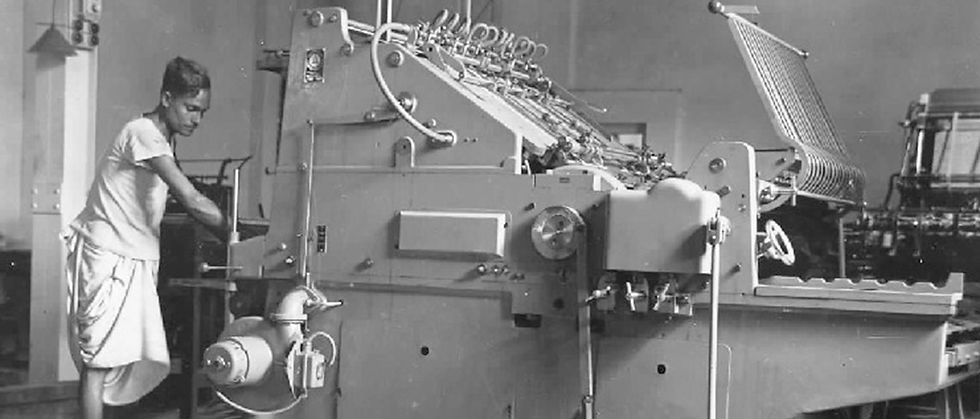The Impact of Print Media on Odia Literary Modernity
- Soumyaranjan Sahoo

- Feb 10
- 4 min read

The advent of print media in the 19th century marked a transformative chapter in the history of Odia literature. It not only revolutionised the way literature was created and disseminated but also catalysed a socio-cultural and intellectual renaissance in Odisha. Before the introduction of printing technology, Odia literature was predominantly preserved and shared through palm-leaf manuscripts, an ancient method that, while artistically rich, was labour-intensive and restricted the accessibility of literary works to a privileged few.
This scenario began to change with the establishment of the first Odia printing typeset in 1836 by Christian missionaries. This revolutionary step enabled the mass production of literary works, newspapers, and magazines, fundamentally altering the literary landscape of Odisha. For the first time, literature transcended the boundaries of elite scholarly circles, reaching the wider public and laying the foundation for a vibrant literary culture.
The Role of Early Odia Publications
The period between 1836 and the late 19th century witnessed the emergence of significant Odia publications that played a pivotal role in shaping modern Odia literature. Among the earliest milestones was the publication of Bodha Dayini in 1861, a magazine launched in Balasore to promote Odia literature and raise awareness about administrative and social issues. This magazine was instrumental in bringing literary works and reformist ideas to the forefront.
Another significant development was the launch of The Utkal Deepika in 1866 under the editorship of Gourishankar Ray. This periodical was one of the earliest examples of print media actively shaping public discourse in Odisha. The Utkal Deepika encouraged modern literary expression, provided a platform for emerging writers, and highlighted issues of cultural identity and governance. It became a rallying point for the Odia intelligentsia, contributing significantly to the linguistic and cultural unification of the state.
Fakir Mohan Senapati and the Dawn of Modern Odia Prose
One of the most enduring legacies of this era was the rise of literary figures like Fakir Mohan Senapati, who is widely regarded as the father of modern Odia literature. The proliferation of print media allowed Senapati’s works to reach a broader audience, setting the stage for contemporary Odia prose. His seminal work, Chha Maana Atha Guntha (Six Acres and a Third), was among the first novels in India to focus on social realism, capturing the struggles of rural Odisha under the feudal system.
Senapati's writings, facilitated by the availability of print media, not only introduced a new narrative style to Odia literature but also created a mirror through which society could examine itself. His ability to blend realism with sharp social commentary was emblematic of how print media was shaping literary expression in Odisha.
Print Media as a Catalyst for Social and Political Change
The influence of print media in Odisha extended well beyond literature, playing a critical role in fostering social and political consciousness. Newspapers and periodicals became forums for public discourse, where reformist ideas, cultural debates, and issues of identity were freely discussed. Publications like The Utkal Deepika and Sambalpur Hiteishini voiced concerns about administrative neglect and cultural marginalisation, galvanising efforts to preserve the Odia language and culture.
Print media also became a tool for nationalism. In the late 19th and early 20th centuries, as the freedom movement gained momentum, newspapers in Odisha reflected the aspirations of the people and mobilised public opinion against colonial rule. Writers and editors used these platforms to promote Odia pride, highlight social injustices, and advocate for educational and cultural reforms.
Print Media and the Formation of Modern Odia Literary Modernity
The rise of print media during this period coincided with the crystallisation of a modern Odia identity. By providing access to a wide range of literary and intellectual works, print media played a crucial role in fostering linguistic unity and cultural pride. The debates and discussions facilitated by newspapers and magazines helped shape the narrative of Odia nationalism and eventually led to the linguistic reorganisation of Odisha as a separate province in 1936.
Moreover, the advent of print media democratised access to knowledge, enabling individuals from diverse social backgrounds to engage with literature and ideas. This inclusivity not only enriched Odia literary culture but also empowered the people of Odisha to claim their cultural and linguistic identity on a national stage.
Legacy and Continuing Influence
The legacy of the print media revolution in Odisha continues to be felt today. It laid the groundwork for a thriving literary culture that embraces both tradition and modernity. The democratisation of literary production and dissemination set a precedent for the development of Odia literature in the digital age, where online platforms and e-books carry forward the spirit of accessibility and innovation that print media first introduced.
While the challenges of preserving regional languages and literature in a globalised world remain, the historical role of print media in shaping Odia literary modernity serves as a reminder of the transformative power of technology in cultural preservation and growth.
The introduction and expansion of print media in Odisha during the 19th century were nothing short of revolutionary. By making literature accessible to the masses, fostering public discourse, and shaping social and political consciousness, print media became an indispensable force in the cultural and intellectual development of Odisha. Its legacy continues to inspire efforts to preserve and promote Odia literature, ensuring that the state’s rich literary heritage remains relevant for future generations.




Comments